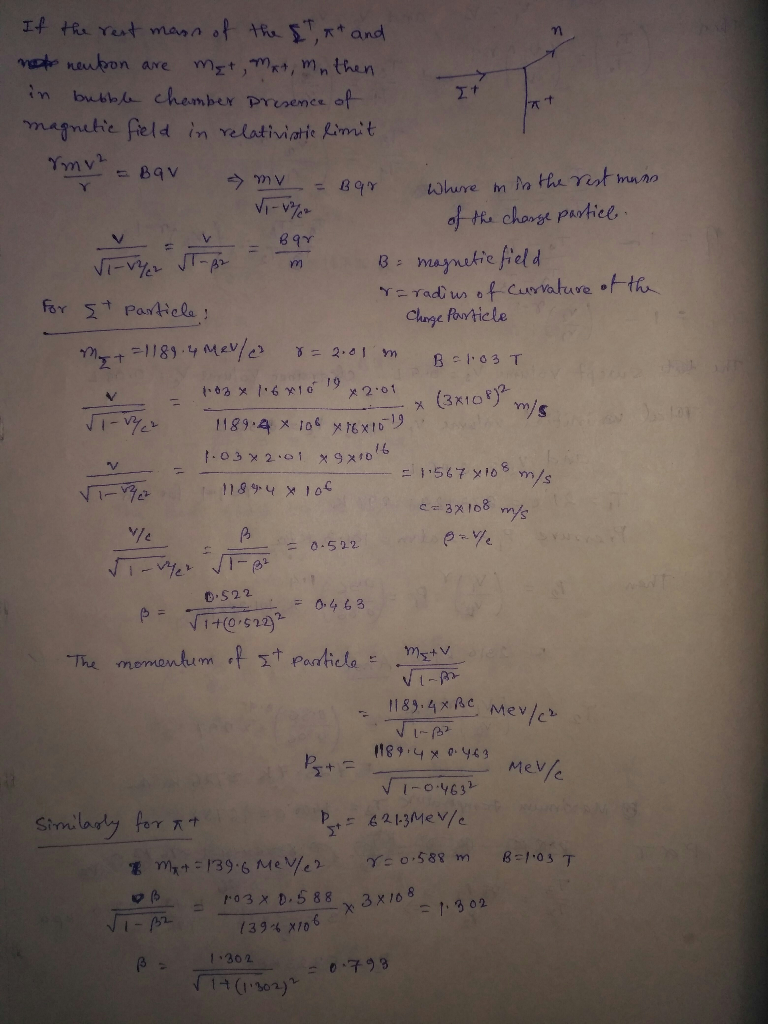Question
In: Physics
In a bubble chamber experiment, the decay of a Σ+ particle into a π+ particle and...
In a bubble chamber experiment, the decay of a Σ+ particle into a π+ particle and a neutron is observed when a 1.03 T magnetic field is applied perpendicular to the paths of the particles. The Σ+ and π+ particles leave curved tracks of radii 2.01 m and 0.588 m respectively. The rest masses are mΣ+ = 1189.4 MeV/c2 and mπ+ = 139.6 MeV/c2. If at the moment of decay, the angle between the momentum of the Σ+ and π+ particles is 71.6°, what is the magnitude of the momentum of the neutron? (Express your answer in units of MeV/c.)
Solutions
Related Solutions
37.44•• A Σ+Σ+ particle has a mean lifetime of 80.2 ps. A physicist measures that mean...
37.44•• A Σ+Σ+ particle has a mean lifetime of 80.2 ps. A
physicist measures that mean lifetime to be 403 ps as the particle
moves in his lab. The rest mass of the particle is 2.12×10−27
kg.2.12×10−27 kg. (a) How fast is the particle moving? (b) How far
does it travel, as measured in the lab frame, over one mean
lifetime? (c) What are its rest, kinetic, and total energies in the
lab frame of reference? (d) What are its...
7. How many σ and π bonds are present in the molecule HCN? A. H ...
7. How many σ and π bonds are present in the molecule HCN? A. H
C N has one σ (H–C) and three π B. H C N has two σ (H–C and
C–N) and two π C. H C N has two σ (H–C and C–N) and one π
8. Draw the Lewis structure for CO2, and predict the number of σ
and π bonds for it. A. Lewis structure of CO2 is...
Given a grammar G, G = (Ν, Σ, Π, S), where Ν = { ... }...
Given a grammar G, G = (Ν, Σ, Π, S), where
Ν = { ... }
Σ = { ... }
Π = { ... }
S is ... For a string ... write
(a) A leftmost derivation
(b) A rightmost derivation
The Cauchy(µ,σ) distribution has the pdf f(x)= 1 σ π 1 1+((x−µ)/σ)2,x ∈R. a. Write an...
The Cauchy(µ,σ) distribution has the pdf f(x)= 1 σ π 1
1+((x−µ)/σ)2,x ∈R.
a. Write an R function that generates a random sample of size n
from a Cauchy(µ,σ)distribution. Do not use the rcauchy function.
Your function should use the inverse transformation from to
generate a random sample from a standard Cauchy distribution, then
transform the generated sample appropriately according to the
location and scale. Hint: The R function for the tangent is
tan(x).
b. Use your function from part...
a) Describe an experiment that points to the particle property of light. b) Describe an experiment...
a) Describe an experiment that points to the particle property
of light.
b) Describe an experiment that describes the wave property of
light.
A uranium-238 nucleus at rest undergoes radioactive decay, splitting into an alpha particle (helium nucleus) with...
A uranium-238 nucleus at rest undergoes radioactive decay,
splitting into an alpha particle (helium nucleus) with mass
6.64×10-27 kg and a thorium nucleus with mass 3.89×10-25 kg. The
measured kinetic energy of the alpha particle is 6.73×10-13 J. If
after the decay, the thorium nucleus is observed to move in the
negative z direction. After the decay, what direction did the alpha
particle move? possible answers: Positive x, Negative x, Positive
y, Negative y, Positive z, Negative z. After the...
4. Each π+ particle in a beam has a momentum of 800 MeV/c. How far will...
4. Each π+ particle in a beam has a momentum of 800 MeV/c. How
far will the beam travel before approximately 10% of the π+ are
left? The π+ rest energy and half-life (at rest) are 140 MeV and 18
nsec, respectively.
Write an example "background" information for exponential decay using beer froth experiment:
Write an example "background" information for exponential decay
using beer froth experiment:
A horizontal disk with radius R and charge density σ is centered originally. A particle with...
A horizontal disk with radius R and charge density σ is centered
originally. A particle with charge Q and mass m is in equilibrium
at a height h above the center of the plate, as shown. A
gravitational field is present. R = 1.5 m σ = -5⋅10-7 C / m2 h = 2
m Q = -2 µC a) Calculate the mass m of the particle if it is at
equilibrium (use g = 9.81 m / s2 )....
Parent Isotope Daughter Isotope Decay Particle (two protons and two neutrons or one electron) Type of...
Parent Isotope
Daughter Isotope
Decay Particle (two
protons and two
neutrons or one electron)
Type of Decay (alpha
or beta)
uranium–238
thorium-234
two protons and two neutrons
alpha decay
thorium-234
Protactinium-234
One electron
Alpha decay
Protactinium-234
Uranium-234
One electron
Beta decay
Uranium-234
Thorium-230
Two protons and two neutrons
Alpha decay
Thorium-230
Radium-226
Two protons and two neutrons
Alpha decay
Radium-226
Radon-222
Two protons and two neutrons
Alpha decay
Radon-222
Polonium-218
Two protons and two neutrons
Alpha decay
Polonium-218
Lead-214
Two...
ADVERTISEMENT
ADVERTISEMENT
Latest Questions
- Do the following problems in Excel. Submit your Excel spreadsheet so I can see how you...
- (For C++) Assume that sentence is a variable of type string that has been assigned a value ....
- List the relational operators recognized by Python, and explain their meanings
- Sports Corp has 11.8 million shares of common stock outstanding, 6.8 million shares of preferred stock...
- How does variety lead to paralysis of action?
- Consider a market consisting of several small pulp & paper mills operating in the South-east. These...
- What are the common types of social media? How do they differ from each other?
ADVERTISEMENT


 genius_generous answered 3 years ago
genius_generous answered 3 years ago